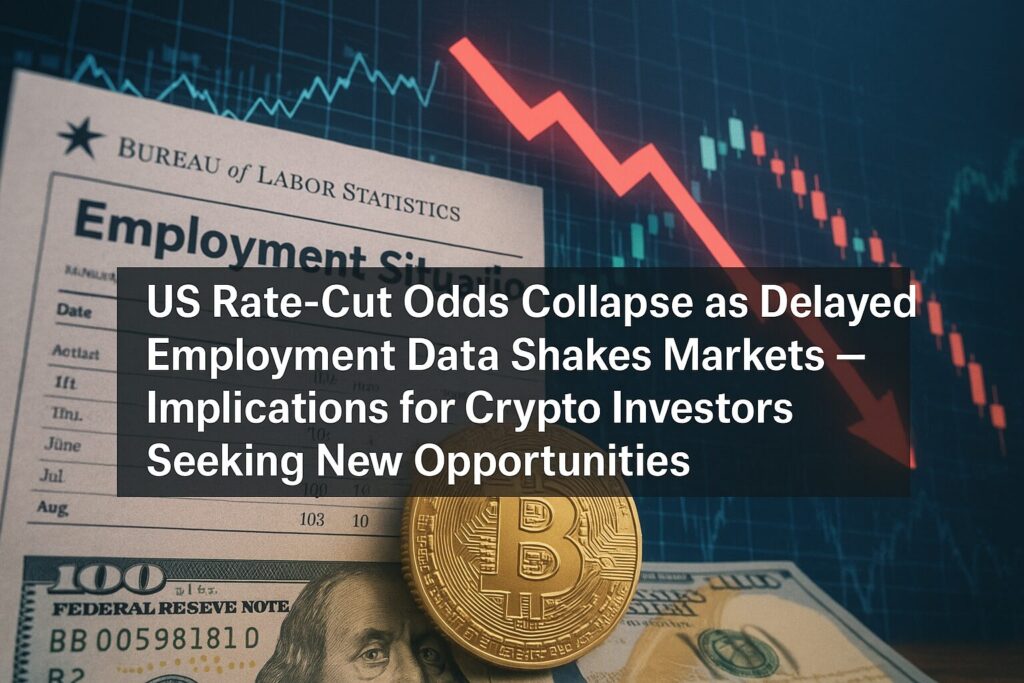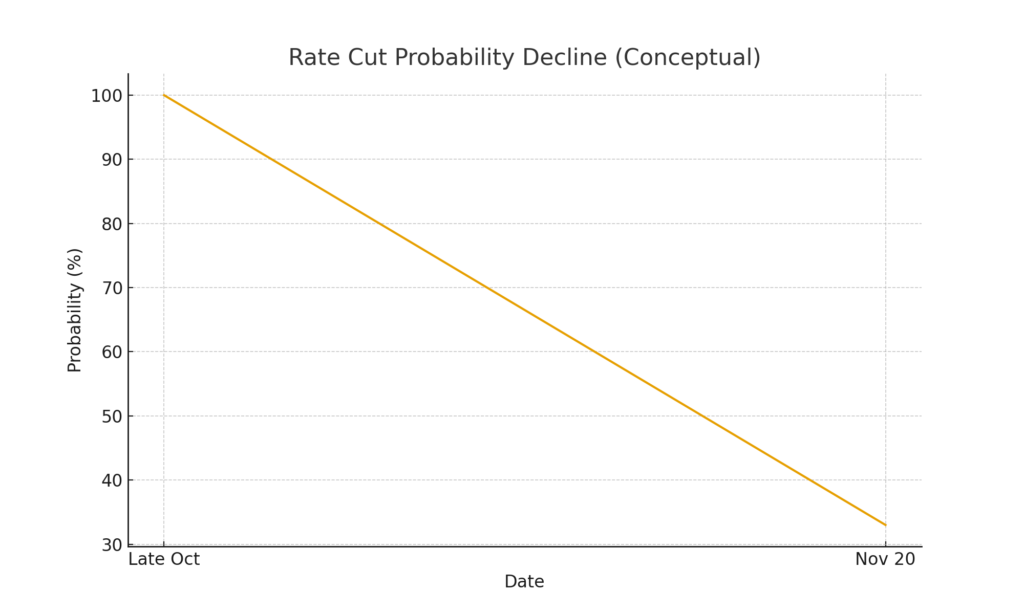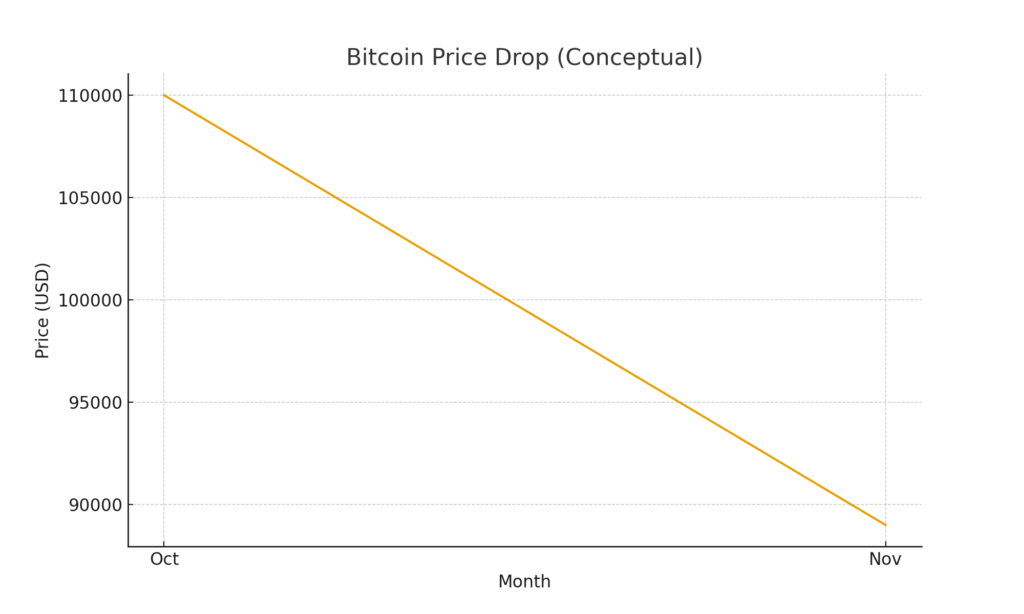
Main Points :
- The U.S. Bureau of Labor Statistics has delayed major employment reports, sharply reducing expectations for a December Fed rate cut.
- Rate-cut odds dropped from nearly 100% to just 33%, causing turbulence across equities and crypto markets.
- Bitcoin and major crypto assets fell sharply as markets reevaluated monetary-policy expectations.
- Stablecoin issuers and crypto-treasury companies saw even larger losses.
- The policy shift significantly affects liquidity, risk appetite, and investor strategy — creating both challenges and new opportunities for utility-driven tokens.
- Political pressure from President Trump adds another layer of uncertainty.
- This article analyzes what these developments mean for crypto investors looking for new assets, yield opportunities, and real-world blockchain applications.
1. Introduction: A Sudden Shock to Market Expectations
In a move that caught global markets off guard, the U.S. Bureau of Labor Statistics (BLS) announced a halt to the October employment report and a delay of the November numbers until after the Federal Reserve’s December policy meeting. The reason cited was the ongoing government shutdown, which has disrupted data-gathering operations.
For financial markets — particularly equities, bonds, and digital assets — this is more than a logistical issue. Real-time labor data is one of the most important inputs used by the Federal Reserve when evaluating interest-rate decisions. Without it, monetary policy becomes less predictable, and unpredictability is historically destabilizing for risk assets.
Only a month ago, traders were nearly certain that the Fed would cut rates in December. The CME FedWatch Tool showed probabilities close to 100%, fueled by expectations of a softening labor market and easing inflation. But now, following the data delay and hawkish comments from Chair Jerome Powell, those odds have plunged to 33%.
Crypto markets reacted swiftly. Bitcoin, which was trading around $110,000 in late October, dropped to $89,000. Ethereum and other large-cap assets followed suit, and crypto-related equities saw even harsher declines. But beneath the volatility lies an important question: Does this shift create opportunities for investors seeking new digital assets or practical blockchain use cases?
This article explores what the rate-cut collapse means, how it affects crypto sentiment, and where strategic investors can find value in a volatile environment.
2. Why the Employment Data Delay Changes Everything
2.1 The Role of Labor Data in Fed Decision-Making
For the past decade, the Fed has increasingly relied on real-time labor and inflation indicators. When job growth slows or unemployment rises, rate cuts become more likely. Conversely, strong employment reduces urgency for monetary easing.
The Fed’s December meeting is one of the most watched events of the year, and typically, policymakers would evaluate:
- Non-farm payrolls
- Unemployment rate
- Wage growth
- Labor participation rate
But now, two months of data are missing or delayed.
2.2 Without Real Data, Hawks Gain the Advantage

Inside the Federal Reserve, there is a well-known internal divide between:
- Hawks: prioritize inflation control and prefer higher interest rates
- Doves: prioritize employment and prefer lower rates
When fresh labor data is absent, hawks tend to dominate the conversation. Without clear evidence of labor weakening, they have no reason to reverse their position.
This is one major reason the December rate-cut odds collapsed so quickly.
3. Market Reaction: Crypto Takes a Steeper Fall
3.1 Bitcoin Drops from $110k to $89k

Bitcoin’s sharp decline reflects a rapid unwinding of expectations around cheap liquidity. Rate cuts typically:
- Increase money supply
- Reduce opportunity cost of holding crypto
- Encourage investors to push into risk assets
With a December cut now unlikely, investors quickly reduced exposure.
3.2 Crypto Equities Hit Even Harder
Some of the biggest losers weren’t tokens, but crypto-related stocks:
- Circle (USDC issuer): −10% on the day, −50% in one month
- Strategy (crypto-treasury firm): −10% on the day, −40% in one month
These companies had been priced for perfection during the previous rally, leaving them vulnerable to macro shocks.
4. Political Pressure Adds Another Layer of Uncertainty
President Donald Trump added heat to the story by publicly criticizing Jerome Powell, stating he would have “already fired him” if not advised otherwise by Treasury Secretary Scott Bessent. Trump also accused Powell of keeping rates “too high,” framing monetary policy as a political issue rather than a purely economic one.
For institutional investors, political interference increases uncertainty. Historically, political turbulence leads to:
- Higher volatility
- Lower risk appetite
- Preference for liquid assets
Crypto often moves in the opposite direction of uncertainty, but in this case, macro-driven liquidity tightening has outweighed speculative demand.
5. What This Means for Crypto Investors
5.1 Short-Term: Volatility and Downside Pressure
The lost employment data removes one of the strongest arguments for immediate monetary easing. Crypto markets may continue experiencing:
- Lower liquidity
- More downside volatility
- Greater sensitivity to macro headlines
Risk-on assets generally struggle during uncertain monetary periods.
5.2 Medium-Term: New Opportunities for Smart Investors
However, selective investors can use this period to accumulate or discover undervalued assets.
Key areas worth attention:
(A) Utility-Driven Tokens
As speculative assets fall, tokens with real use cases — payments, remittances, DeFi infrastructure — attract stronger interest.
Examples include:
- Cross-border settlement tokens
- Stablecoin infrastructure tokens
- Layer-1 chains with real commercial adoption
(B) Yield-Generating Environments
Investors increasingly seek:
- Real-world tokenized assets (RWA)
- Blockchain-based treasury products
- Staking models with transparent value accrual
(C) Assets Built for Institutional Integration
Institutions continue accumulating selectively during market pullbacks, especially assets that complement financial infrastructure.
6. Broader Trend: “Smart Money” Buying During Weakness
Despite retail panic selling, blockchain analytics show consistent accumulation by large wallets. This bifurcation between smart money and retail investors suggests that the current downturn is driven more by macro developments than by deteriorating crypto fundamentals.
Historically, similar situations — such as the 2020 COVID liquidity crunch or the 2018 pre-halving downturn — later produced generational buying opportunities.
7. New Digital Assets and Real-World Blockchain Use Cases Rising
Even amid macro tightening, several new sectors show strong momentum:
7.1 Tokenized Real-World Assets (RWA)
Treasury-backed stablecoins and bond-tokenization platforms continue gaining institutional traction.
Even during downturns, RWA products tend to remain stable due to their yield-driven nature.
7.2 Utility Tokens Within Regulated Ecosystems
Regulated fintech ecosystems — such as licensed VASP/EMI environments — are emerging as safer on-ramps for new investors.
Tokens embedded in these systems offer:
- Real transaction utility
- Lower volatility
- Regulatory clarity
7.3 Cross-Chain Payment Solutions
As banking digitization accelerates, fast-settlement blockchain rails are in demand.
Crypto assets connected to payments, remittances, or settlements may see structural growth regardless of temporary macro turbulence.
8. Outlook: What to Watch Going Forward
Key upcoming events:
- Release of the September employment report
- Fed’s December policy meeting
- Inflation updates in December and January
- Treasury financing announcements
- Institutional fund flows
Even though the September data is outdated, it will be the only labor-related datapoint before the December meeting. Its influence will be limited but not zero.
9. Conclusion: Navigating Uncertainty While Finding Strategic Opportunities
The abrupt collapse in rate-cut expectations has introduced new uncertainty into global markets. Crypto assets, which had rallied aggressively in October, have corrected sharply as investors reassess liquidity conditions.
Yet uncertainty also creates opportunity.
Investors who understand the macro environment and focus on utility-driven, real-world blockchain applications may find attractive entry points during the current downturn. While speculative assets remain fragile, tokens tied to payments, infrastructure, compliance, and financial integration may outperform entering 2026.
Liquidity may be tightening, but innovation continues. And for investors seeking new crypto assets or sustainable revenue models, this environment — though challenging — may offer the best opportunities in years.

